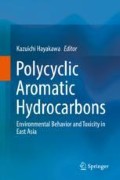Abstract
Polycyclic aromatic hydrocarbons (PAHs) are composed of two or more fused aromatic (benzene) rings which contain only carbon and hydrogen. They are converted to derivatives including metabolites such as hydroxyl, quinoid, nitrated and halogenated PAHs. In order to understand their behaviours and toxicities, an understanding of the fundamental chemistry of PAHs and their derivatives is important. This chapter deals with their structure and properties, nomenclature, sources and toxicity.
Access this chapter
Tax calculation will be finalised at checkout
Purchases are for personal use only
References
Arce R, Morel M (2013) Phototransformations of dinitropyrene isomers on models of the atmospheric particulate matter. Atmos Environ 75:171–178
Baker E, Eisenreich J (1990) Concentrations and fluxes of polycyclic aromatic hydrocarbons and polychlorinated biphenyls across the air-water interface of lake superior. Environ Sci Technol 24:342–352
Bisht DS, Dumka U, Kaskaoutis D, Pipal AS, Srivastava AK, Soni VK, Attri SD, Sateesh M, Tiwari S (2015) Carbonaceous aerosols and pollutants over Delhi urban environment: temporal evolution, source apportionment and radiative forcing. Sci Total Environ 521-522:431–445
Bran S, Srivastava R (2017) Investigation of PM2.5 mass concentration over India using a regional climate model. Environ Pollut 224:484–493
Burczynski ME, Penning TM (2000) Genotoxic polycyclic aromatic hydrocarbon ortho-quinones generated by aldo-keto reductases induce CYP1A1 via nuclear translocation of the aryl hydrocarbon receptor. Cancer Res 60:908–915
Cron T, Tolstoy M (2010) Magnitude of the 2010 Gulf of Mexico oil leak. Sci 330:634
Dalton T, Jin D (2010) Extent and frequency of vessel oil spills in US marine protected areas. Mar Pollut Bull 60:1939–1945
Embassy of the United States, Beijing-China (2015) Beijing current AIQ (State Department Air Monitoring Website. http://beijing.usembassy-china.org.cn
Feng J, Yang Y, Niu J, Shen Z (2007) Remobilization of polycyclic aromatic hydrocarbons during the resuspension of Yangtze River sediment using a particle entrainment simulator. Environ Pollut 149:193–200
Gade M, Alpers W (1999) Using ERS-2 SAR images for routine observation of marine pollution in European coastal waters. Sci Total Environ 237-238:441–448
Goodbody-Gringley G, Wetzel DL, Gillon D, Pulster E, Miller A, Ritchie KB (2013) Toxicity of Deepwater horizon source oil and the chemical dispersant, Corexit® 9500, to coral larvae. PLoS One 8:e45575
Haney CJ, Geiger HJ, Short JW (2014) Bird mortality from the Deepwater horizon oil spill. I. Exposure probability in the offshore Gulf of Mexico. Mar Ecol Prog Ser 513:225–237
Hayakawa K, Onoda Y, Tachikawa C, Hosoi S, Yoshita M, Chung SW, Kizu R, Toriba A, Kameda T, Tang N (2007) Estrogenic/antiestrogenic activities of polycyclic aromatic hydrocarbons and their monohydroxylated derivatives by yeast two-hybrid assay. J Health Sci 53:562–570
Hirose T, Morito K, Kizu R, Toriba A, Hayakawa K, Ogawa S, Inoue S, Muramatsu M, Masamune Y (2001) Estrogenic/antiestrogenic activities of polycyclic aromatic hydrocarbons and their monohydroxylated derivatives by yeast two-hybrid assay. J Health Sci 47:552–558
IARC (2013) IARC air pollution and cancer. WHO, Lyon
IARC (2017) IARC monographs on the evaluation of the carcinogenic risks to humans. WHO, Geneva
Kizu R, Ishii K, Kobayashi J, Hashimoto T, Koh E, Namiki M, Hayakawa K (2000) Antiandrogenic effect of crude extract of C-heavy oil. Mater Sci Eng C 12:97–102
Kumagai Y, Koide S, Taguchi K, Endo A, Nakai Y, Yoshikawa T, Shimojo N (2000) Oxidation of proximal protein sulfhydryls by phenanthrenequinone, a component of diesel exhaust particles. Chem Res Toxicol 15:483–489
Mackay DY, Wan S, Kuo CM (1992) Illustrated handbook of physical-chemical properties and environmental fate for organic chemicals. CRC Press (Lewis Publishers), Boca Raton
Moss GP (1998) IUPAC nomenclature of fused and bridged fused ring systems. Pure Appl Chem 70:143–216
Motoyama Y, Bekki K, Chung SW, Tang N, Kameda T, Toriba A, Taguchi K, Hayakawa K (2009) Oxidative stress more strongly induced by ortho- than para-quinoid polycyclic aromatic hydrocarbons in A549 cells. J Health Sci 55:845–850
Murayama M, Dasgupta P (1996) Liquid chromatographic determination of nitro-substituted polynuclear aromatic hydrocarbons by sequential electrochemical and fluorescence detection. Anal Chem 68:1226–1232
Nakagawa R, Kitamori S, Horikawa K, Nakashima K, Tokiwa H (1983) Identification of dinitropyrenes in diesel-exhaust particles their probably presence as the major mutagens. Mutat Res Genet Toxicol 124:201–211
Saarnio K, Sillanpää M, Hillamo R, Sandell E, Pennanen AS, Salonen RO (2008) Polycyclic aromatic hydrocarbons in size-segregated particle matter from six urban site in Europe. Atmos Environ 42:9087–9097
Statistical BP (2015) Review of world energy. https://www.bp.com
Stieglitz JD, Mager EM, Hoenig RH, Benetti DD, Grosell M (2016) Impacts of Deepwater Horizon crude oil exposure on the adult mahi-mahi (Coryphaena hippurus) swim performance. Environ Toxicol Chem 10:2613–2622
Van de Wiele T, Vanhaecke L, Boeckaert C, Peru K, Headley J, Verstraete W, Siciliano S (2005) Human colon microbiota transform polycyclic aromatic hydrocarbons to estrogenic metabolites. Environ Health Perspect 113:6–10
Author information
Authors and Affiliations
Corresponding author
Editor information
Editors and Affiliations
Rights and permissions
Copyright information
© 2018 Springer Nature Singapore Pte Ltd.
About this chapter
Cite this chapter
Hayakawa, K. (2018). Chemistry of Polycyclic Aromatic Hydrocarbons (PAHs), Nitropolycyclic Aromatic Hydrocarbons (NPAHs) and Other Oxidative Derivatives of PAHs. In: Hayakawa, K. (eds) Polycyclic Aromatic Hydrocarbons. Springer, Singapore. https://doi.org/10.1007/978-981-10-6775-4_1
Download citation
DOI: https://doi.org/10.1007/978-981-10-6775-4_1
Published:
Publisher Name: Springer, Singapore
Print ISBN: 978-981-10-6774-7
Online ISBN: 978-981-10-6775-4
eBook Packages: Biomedical and Life SciencesBiomedical and Life Sciences (R0)

